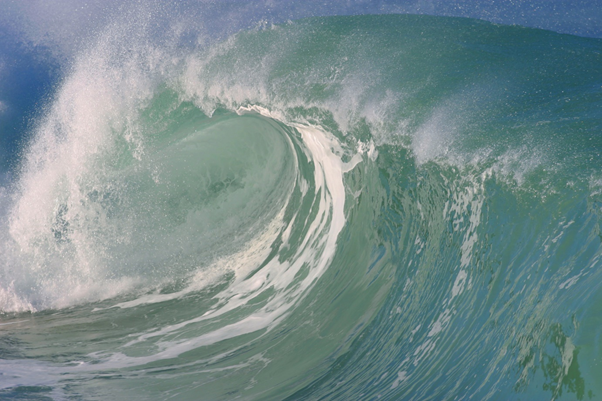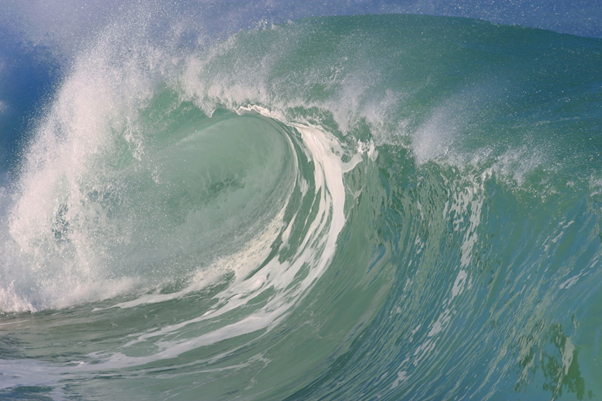What is Tidal Energy?

Source: © Nalukai | Megapixl.com
Tidal energy is a form of renewable energy in which the ocean's tidal kinetic energy is converted into electrical energy. The tidal waves push the turbines and ultimately generate electricity. The energy harnessed from tidal source is carbon-free energy and can be used for household as well as industrial purposes. However, the technology is not used extensively across the globe because of the limited availability and relatively higher cost of harnessing tidal energy.
How causes Tides in the ocean?
Tides are created by the gravitational pull between the earth and moon. Isaac Newton's Universal Gravitational Law states that every two body in this universe attracts each other with a force that is directly proportional to the masses of both the bodies and inversely proportional to the distance between both the bodies. The force exerted by the first object on the second object is directly proportional to the mass of the first object and inversely proportional to the distance between the centres of both objects. Since the moon is the closest heavily body, it exerts an enormous force on the water bodies which generates tides in the ocean.
The Sun is around 27 million times larger than the moon and based on its mass, exerts a force that is around 177 times greater than that of the moon. Such higher force has the capability to create 27 million times greater tides than that of the moon, but the distance between the Sun and the earth is around 390 times greater than the earth and moon, which nullifies the force by 59 million times than the moon.
How can Tidal Energy be harnessed?

Source: © Alexmit | Megapixl.com
There are numerous ways to harness tidal energy, including tidal streams, tidal lagoons and barrages. Let us discuss them one by one.
Tidal Stream: It is a fast-flowing water body created by tides. The process of converting energy from tidal streams is much similar to that of wind energy. Turbines are placed in tidal streams to convert the energy of tides into electrical energy. Because of the relatively higher density of water compared to wind, tidal energy is more powerful than wind. Tidal generators provide a reliable and steady flow of electricity. Tidal turbines are placed on the seafloor based on the tidal flow. These turbines are costlier than wind turbines, but they have the capability to capture more energy with nearly similar blade size.
Tidal Lagoon: Tidal lagoon is a part of an ocean's body that is partially closed by a natural or human-made barrier. These lagoons are built along the natural coastline. A turbine is installed into the lagoon, which rotates on the basis of filling and emptying the lagoon. The environmental impacts of constructing a lagoon are relatively less as these lagoons are mostly made up of natural rocks, and they don't disturb the natural ecosystem of the ocean.
Tidal Barrages: Tidal barrages are very much similar to a dam. Tidal barrages are installed at the inlet of a lagoon or any tidal basin. The flow of water and its flow rate to the basin is controlled by the sluice gates present on the barrage. Turbines are installed inside the barrages, which are used to harness tidal energy in a similar fashion as in the case of a river. During high tides, the gates of the barrage are closed, creating a pool. The water is then released through turbines in a controlled manner to generate electricity.
Summary:
- Tidal energy is a form of renewable and carbon-free source of energy in which the ocean's tidal action is converted into electrical energy.
- Tides in the ocean are generated by the attraction force exerted by the moon on the earth. This force creates tides in the ocean.
- There are three main methods to harness tides: tidal barrages, tidal lagoons, and tidal streams.
Frequently Asked Questions (FAQs):
What are the advantages of tidal energy?

Source: © Seoterra | Megapixl.com
There are various advantages of tidal energy. Let us discuss the most important advantages of tidal energy in brief.
- Clean Energy: Tidal energy is a clean and green source of energy that is carbon independent and produces no greenhouse gases.
- Compact Energy Source: The area requirement for tidal energy is much less than another renewable energy source, which makes it a compact source of energy. Even smaller countries having a substantial stretch of coastline can harness and utilise tidal energy.
- Continuous and Predictable: Tidal energy provides an uninterrupted flow of energy because tides are not going to stop. It is also a predictable source of energy compared to wind energy because of already know high-low tide cycles.
- Equipment Longevity: The longevity of tidal powerplants is much higher than wind or solar power plants. Tidal barrages are said to have a life of around 100 years. On the flipside, wind turbines and solar panels come with a warranty ranging from 20—15 years only.
What are the disadvantages of Tidal Energy?
Tidal energy has a lot of advantages, but it doesn't mean that it doesn't have any disadvantages. Let's glance at some of the disadvantages of tidal energy.
- High Construction Cost: The installation of tidal power plants requires a huge amount of money, making it an expensive source of energy and limiting its reach.
- Environmental Issues: However, tidal energy is a carbon-free source of energy that doesn't create any greenhouse gas, but it is responsible for affecting the natural habitat, particularly with tidal barrages.
- Equipment Maintenance: The repair and maintenance of equipment and machinery could be challenging in case of failure.
- Storage Cost: Powerful tides normally occur about 10 hours per day, so additional batteries are required for the storage of energy for utilisation at a later stage. However, the installation of batteries increases the cost to the next level.
 Please wait processing your request...
Please wait processing your request...